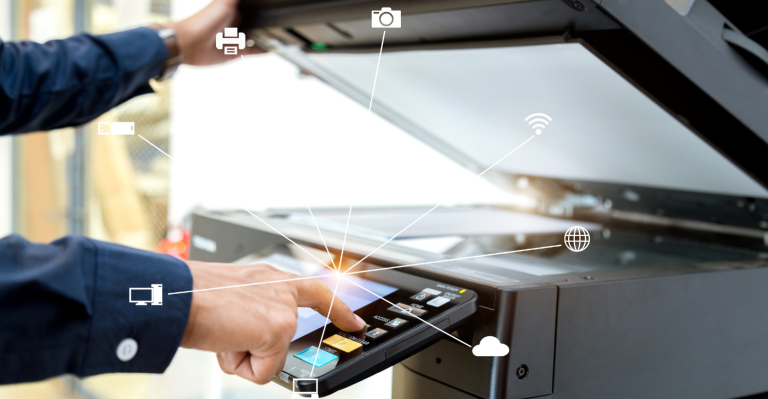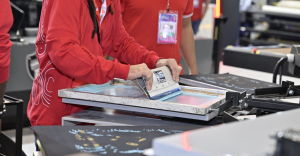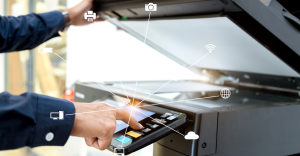Web-to-Print, also known as Web2Print, is a model that connects online platforms to printing systems, enabling orders, customizations, and productions to occur entirely digitally and automatically.
In practice, the customer does everything online: chooses templates, customizes texts and images, uploads files, and approves proofs through an intuitive interface. The system then sends the files directly to production, eliminating manual steps and reducing errors.
The difference from traditional printing is significant. While the classic model relies on several in-person steps (such as plate creation, physical proofs, and minimum print runs), Web-to-Print allows for an on-demand, fully integrated, and faster workflow.
Web2Print: Benefits for Print Shops and Entrepreneurs
Reduction in Operational Costs
By automating steps such as file upload, review, and checking, Web-to-Print reduces rework and waste. This significantly lowers costs related to labor and materials. Additionally, on-demand production eliminates the need to maintain large inventories of ready-made products, avoiding losses and optimizing physical space.
Speed in Service and Production
The process becomes faster and simpler, as orders can be placed at any time, with digital approvals and pre-configured templates. This shortens lead times and improves the customer experience, enabling faster deliveries—an essential factor in an increasingly competitive market.
Expansion of Sales Channels
By integrating Web-to-Print with e-commerce platforms, print shops and entrepreneurs can offer customizable virtual stores, catering to both end consumers (B2C) and businesses (B2B). This model broadens the business’s reach and opens doors to new audiences without relying solely on in-person service.
Practical Applications of Web-to-Print in the Printing and Textile Industry
Custom T-Shirt Printing
In the textile sector, Web-to-Print allows customers to create their own designs, choose colors and sizes, and preview the product before production. Personalization is sent directly for screen printing, sublimation, or digital textile printing, ensuring agility and reducing costs with minimum batches.
On-Demand Visual Communication
Print shops and visual communication bureaus can fulfill orders for banners, stickers, tarpaulins, and customized signs entirely online. Promotional campaigns and events, for example, can have printed materials produced on demand, in exact quantities, and with quick deliveries.
Promotional Products and Corporate Gifts
The model is also ideal for the personalized gift market, such as mugs, tote bags, keychains, and other promotional items that can be customized with logos, names, or messages. Everything is configured online, with a preview of the result before printing, reducing returns and rework.
Automation and System Integration
The success of Web-to-Print depends on the integration between management and production software. Key tools involved include:
- ERP (Enterprise Resource Planning): Controls inventory, materials, and finances.
- CRM (Customer Relationship Management): Manages customers, order history, and relationships.
- E-commerce platforms: Allow customers to customize and purchase products directly.
- Prepress and RIP software: Automates digital proofs, color adjustments, and file verification.
A typical automated workflow might follow this sequence:
The customer accesses the website → customizes the product → uploads the file → approves the digital proof → the system automatically sends it to production → quality control → shipping → final delivery.
This type of integration reduces bottlenecks and allows businesses to scale without proportionally increasing the team size.
Trends and Innovation with Web-to-Print
Mass Personalization and Artificial Intelligence
Personalization is one of Web-to-Print’s major differentiators. With variable data, it is possible to change names, colors, and images for each product within the same print run.
Today, artificial intelligence (AI) can already be used to automatically generate layouts, suggest design combinations, optimize colors, and predict demand based on customer behavior. This improves efficiency and expands creative possibilities in the production process.
Sustainable and On-Demand Printing
By producing only what is ordered, Web-to-Print helps reduce waste of paper, ink, and energy. Additionally, the model encourages the use of eco-friendly materials, water-based inks, and recyclable substrates, aligning with the sustainability goals of the printing industry.
3D and Hybrid Printing
Although still less common, the integration of traditional printing with 3D printing is beginning to emerge in niches such as personalization, decoration, and prototyping. This convergence expands the concept of Web-to-Print, extending it to new dimensions of on-demand production.

Success Stories in Brazil
One of the main national examples is the Isidora platform, which has established itself as one of the most widely used Web-to-Print solutions in the country. According to Revista Desktop, there are already about 50 installations or implementations underway, offering an intuitive interface, support for B2B and B2C websites, and automatic generation of print-ready files.
Another case is Auryn, which develops complete solutions for quick print shops, bookbinders, and photographers. The platform integrates product showcases, online customization, and production automation, demonstrating that small businesses can also benefit from digitalization.
These examples prove that investing in Web-to-Print is not exclusive to large companies but an accessible strategy that democratizes innovation and improves profitability in the sector.
How to Start Working with This System
Before implementing a Web-to-Print system, it is important to conduct an internal diagnosis:
- Map the current production flow: Identify bottlenecks, repetitive tasks, and recurring errors.
- Choose the products to offer on demand: T-shirts, gifts, visual communication, etc.
- Evaluate available platforms for integration: Check if they offer customizable templates, ERP and CRM integration, and local support in Portuguese.
- Invest in user experience: The easier the customization process, the lower the rework rate.
- Train the team: Even with automation, mastering the systems ensures better productivity and service.
- Monitor metrics: Deadlines, error rates, customer satisfaction, and order volume help continuously improve the service.
Among the platforms available in the Brazilian market, there are options that vary in complexity and price. Research to choose one that suits the size and strategy of your business.
Web-to-Print: New Possibilities for the Printing Market
Web-to-Print is redefining how the printing market operates. By combining automation, personalization, and digital integration, it offers entrepreneurs the opportunity to scale their business, reduce costs, and serve customers more quickly and sustainably.
More than a trend, it is a natural evolution of the printing sector, both graphic and textile, towards a more efficient and connected operation.
Companies that adopt the on-demand model gain clear competitive advantages: less waste, more flexibility, and a modern shopping experience.
For those looking to start, the key lies in taking strategic steps, choosing good tools, structuring processes, and training the team. Thus, Web-to-Print ceases to be a distant innovation and becomes a real growth opportunity in the digital printing and visual communication market.




